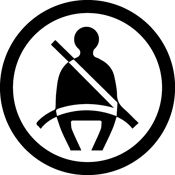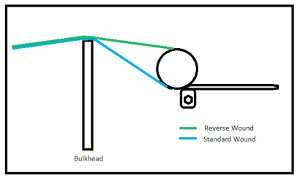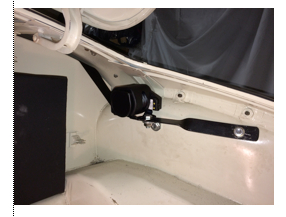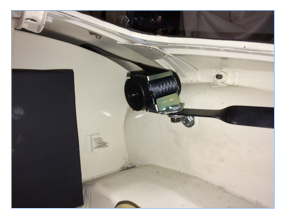Inertia Reel Seatbelt Options for the MGA

 When I recently bought my MGA, I was surprised to find that it had never had belts of any type fitted. This made adding them a priority if I and my family (including young passengers) were to safely enjoy the car.
When I recently bought my MGA, I was surprised to find that it had never had belts of any type fitted. This made adding them a priority if I and my family (including young passengers) were to safely enjoy the car.
I immediately started considering inertia reel-based systems, and found it quite confusing. Everyone seemed to have a different take on how to do this and in some cases, the fixing methods seemed questionable also.
After much research, I settled on a kit that would bolt to the rear arch at multiple points, with the retractor units situated up inside the wheel arches in the boot. The belts would then feed through a gap in the bulkhead, attach to an eyelet on the outside chassis of each side, then over to receivers which were bolted through the transmission tunnel, to welded plates on the chassis.
Brendan Leach’s article from Safety Fast of September 2016 provides an excellent overview of this solution and we used the same supplier. However, it is worth owners considering something that tripped both of us up in this installation. As standard, the belts are supplied standard wound, i.e. they unwind clockwise, exiting the reel mechanism at 6’oclock. They are described as a ‘parcel shelf mount’ system, as they are designed to lay on a flat surface, and the brackets rely on them being horizontal to work properly. But in the MGA, even fixed high inside the boot on the arch, their exit point means that the belt has to go up and over the bulkhead at a less than optimum angle.
By comparison, a reverse-wound option, where the belt unwinds from the retractor anti-clockwise, exits at a 12 o’clock position; this results in a far flatter angle from the mechanism to the bulkhead. A simple diagram describes this:
 This situation can be more acute according to how close to the bulkhead you choose to fit the reels. Those looking to optimise space may end up with even steeper angles than this, when using a standard- wound option.
This situation can be more acute according to how close to the bulkhead you choose to fit the reels. Those looking to optimise space may end up with even steeper angles than this, when using a standard- wound option.
Why might this matter? There are several considerations:
1. Where standard wound, the increased angle will result in increased friction. (A piece of felt, or furflex that wraps over the bulkhead will assist here and reduce chafing of the webbing, but better to reduce it as much as possible in the first place).
2. In an emergency stop situation, an increased angle here would create more pressure on the rear of the bulkhead.
Initially, having been supplied with standard-wound (and not being aware of a reverse option) I attempted to compensate for this angle, by bringing back the fixing point from the bulkhead. However, based on an exchange with Brendan, based on his article, I learned of this option, which was the route he had also taken. The before and after pictures below illustrate the difference, using the same mounting points. (thankfully I have a white car, so it shows up nicely).
 Along with the reel winding, another item that may be worth considering is the receiver, or part of the belt that the seatbelt clips into. Ideally, the buckle should fasten low on the hip. But in cars with low seats (such as the MGA) the receivers provided are of a fixed length, which can be too long – particularly those on stalks. The answer here is to ask for an adjustable option.
Along with the reel winding, another item that may be worth considering is the receiver, or part of the belt that the seatbelt clips into. Ideally, the buckle should fasten low on the hip. But in cars with low seats (such as the MGA) the receivers provided are of a fixed length, which can be too long – particularly those on stalks. The answer here is to ask for an adjustable option.
 As a final note, it is surprising how many seat belt kits for our cars seem to be offered in standard-wound reel only. My suggestion to other owners considering adding or updating their seatbelts would be to ask your supplier about this option before you purchase – it may be available, but they may not offer it.
As a final note, it is surprising how many seat belt kits for our cars seem to be offered in standard-wound reel only. My suggestion to other owners considering adding or updating their seatbelts would be to ask your supplier about this option before you purchase – it may be available, but they may not offer it.
But potentially, it could make a big difference to the effectiveness of your belts.


Comment by: Philippe F Tusler
I installed static belts, bolted high on the wheel arch in the passenger compartment. That said, I have never felt them to be satisfactory, as they are still anchored below my shoulder height, and they tend to slip off my shoulder. This is uncomfortable, inconvenient, and I’m sure that in the case of an accident, would not provide restraint. So I tend to use them as lap-belts, which is obviously less safe.
Comment by: Gary S Lock
The Securon belts as used in the MGB GT (Part # SBS 514/30) are great. They have angle adjustment for sloping fix points. I always use Todd Clarkes kit for the brackets. Moss sells the Securon belts.